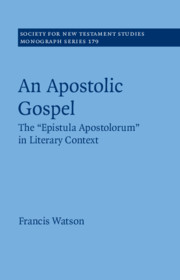Book contents
- An Apostolic Gospel
- Society for New Testament Studies
- An Apostolic Gospel
- Copyright page
- Contents
- Acknowledgements
- Introduction
- Part I Recovering the Epistula
- Part II Themes
- 3 The Miracle Sequence
- 4 Resurrection and Eschatologies
- 5 Narratives of Incarnation
- 6 Paul and the Apostolic Mission
- 7 Vindicating Divine Justice
- Part III Additional Notes on Text and Translation
- Appendix: The Galilean Discourse
- Bibliography
- Author Index
- Subject Index
5 - Narratives of Incarnation
from Part II - Themes
Published online by Cambridge University Press: 13 March 2021
- An Apostolic Gospel
- Society for New Testament Studies
- An Apostolic Gospel
- Copyright page
- Contents
- Acknowledgements
- Introduction
- Part I Recovering the Epistula
- Part II Themes
- 3 The Miracle Sequence
- 4 Resurrection and Eschatologies
- 5 Narratives of Incarnation
- 6 Paul and the Apostolic Mission
- 7 Vindicating Divine Justice
- Part III Additional Notes on Text and Translation
- Appendix: The Galilean Discourse
- Bibliography
- Author Index
- Subject Index
Summary
Like other second-century authors, the author of EpAp combines Johannine incarnational theology with the Lukan miraculous conception account and views the miraculous conception as the means by which the incarnation took place. Unlike the canonical evangelists, this author also provides an account of the pre-existent Jesus’ descent from heaven, adopting angelic disguise. Thus the angel Gabriel in the Lukan annunciation story is here the Son of God in angelic form, who brings about his own incarnation in Mary’s womb without assistance from the Holy Spirit. EpAp thus narrates the entire process of incarnation, following the precedent of the angelic transformation schema depicted in the Ascension of Isaiah. In that text, the event of incarnation appears to take place not at conception but at the birth itself – a point of agreement with an otherwise quite different ‘narrative of incarnation’ in the Protevangelium of James. So-called ‘adoptionist’ christologies may better be understood as attempts to narrate the incarnation, now identified with the descent of the Spirit/Christ at Jesus’ baptism.
Keywords
- Type
- Chapter
- Information
- An Apostolic GospelThe 'Epistula Apostolorum' in Literary Context, pp. 134 - 163Publisher: Cambridge University PressPrint publication year: 2020

